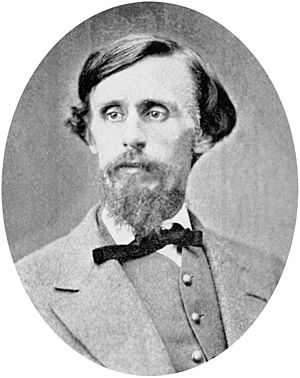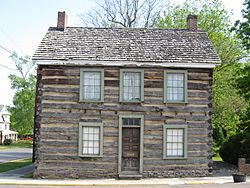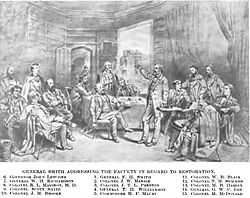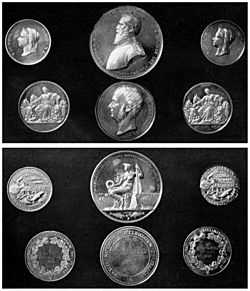Marshall McDonald facts for kids
Quick facts for kids
Marshall McDonald
|
|
|---|---|

Portrait of Marshall McDonald
|
|
| United States Commissioner of Fish and Fisheries |
|
| In office 1888–1895 |
|
| President | Grover Cleveland Benjamin Harrison |
| Preceded by | George Brown Goode |
| Succeeded by | John J. Brice |
| Chief Assistant Commissioner of the United States Commission of Fish and Fisheries | |
| In office 1885–1888 |
|
| Personal details | |
| Born | October 18, 1835 Romney, Virginia (now West Virginia), U.S. |
| Died | September 1, 1895 (aged 59) Washington, D.C., U.S. |
| Resting place | Oak Hill Cemetery, Georgetown, Washington, D.C. |
| Spouse | Mary Eliza McCormick |
| Relations | Angus McDonald (great-grandfather) Angus McDonald (grandfather) Angus William McDonald (father) Edward Allen Hitchcock McDonald (brother) |
| Children | 4 |
| Parents | Angus William McDonald Leacy Anne Naylor |
| Alma mater | University of Virginia Virginia Military Institute |
| Occupation | Engineer, professor, geologist, mineralogist, pisciculturist, and fisheries scientist |
| Military service | |
| Allegiance | |
| Branch/service | |
| Years of service | 1861–1865 |
| Rank | |
| Battles/wars | American Civil War |
Marshall McDonald (born October 18, 1835 – died September 1, 1895) was an American engineer, geologist, mineralogist, and fisheries scientist. He was also known as a pisciculturist, meaning someone who raises fish.
McDonald served as the head of the United States Fish Commission from 1888 until his death in 1895. He was famous for inventing special equipment to help fish hatch and a "fish ladder." This ladder allowed salmon and other migrating fish to swim up rapids in rivers. This helped them reach more places to lay their eggs. McDonald's time leading the U.S. Fish Commission was known for being honest and focused on protecting and growing fish populations across the United States.
Contents
Early Life and Education
Marshall McDonald was born in 1835 in Romney, Virginia (which is now West Virginia). His father, Angus William McDonald, was a military officer and a lawyer. His mother was Leacy Anne Naylor. Marshall was the sixth of nine children.
From 1854 to 1855, McDonald studied natural history at the Smithsonian Institution in Washington, D.C.. He learned from Spencer Fullerton Baird, a famous scientist. After that, he went to the University of Virginia and the Virginia Military Institute. He graduated from the Virginia Military Institute in 1860. McDonald then became an assistant professor of chemistry there, working under Stonewall Jackson. He continued to teach sometimes during the American Civil War.
Military Service in the Civil War
McDonald joined the Confederate States Army in 1861. He became a lieutenant and an engineer officer. He worked on the staff of his former professor, Stonewall Jackson. Later, he served as an engineer officer for other generals.

In 1863, the Union Army captured McDonald at Vicksburg, Mississippi, and he became a prisoner of war. While on parole (a promise not to fight), he returned to the Virginia Military Institute to teach students. One of his students, John Sergeant Wise, remembered McDonald teaching with a crutch because of an injury.
McDonald was promoted to major and later to colonel and brigadier general by the end of the war. He and his four brothers all served in the Confederate Army. Only three of his brothers survived the war.
After the War: Professor and Fish Farmer
After the war ended in 1865, McDonald went back to the Virginia Military Institute. He became a professor with the rank of colonel. He taught and led departments in chemistry, geology, mineralogy, and metallurgy. He also started the school's first museum.

By 1875, McDonald became very interested in fish farming. He became the manager of Virginia's state fish hatchery in Wytheville. Soon after, he was named the Fish Commissioner of Virginia. During this time, he invented the "McDonald fish ladder." This invention helped salmon and other fish swim up fast-moving rivers to reach more places to lay their eggs.
In 1879, Spencer Fullerton Baird, his former teacher from the Smithsonian, offered McDonald a job at the United States Fish Commission. McDonald accepted and left his job in Virginia.
Leading the U.S. Fish Commission
At the United States Fish Commission, McDonald first worked as a special agent. He helped collect information about fisheries for the 1880 U.S. Census. Later, he became the superintendent of the shad hatcheries on the Potomac River. He was also in charge of giving out young fish and "food-fishes" to state fisheries. Eventually, he became the Chief Assistant Commissioner.
In January 1888, President Grover Cleveland chose McDonald to be the Commissioner of Fish and Fisheries. People thought he was an excellent choice because of his experience and leadership skills. As Commissioner, McDonald had three yachts and 22 fishing stations to help with his research and work.
One of McDonald's main goals was to study American fisheries and fish culture in great detail. He wanted to understand what fish eat, calling it "aquatic pastorage," to help fish populations grow.
Fish Hatching Inventions
Throughout his time at the Fish Commission, McDonald created many new and useful devices for hatching fish. In 1871, he invented automatic hatching jars. These jars changed fish farming by making it easier to separate healthy fish eggs from dead ones. This invention helped the Fish Commission successfully grow and distribute many fish.
In 1880, he designed a special box for cod eggs. This box created a gentle "tidal motion" that was needed for these floating eggs to hatch. He also developed a similar device for hatching floating halibut eggs and other ocean fish eggs. These inventions made hatching fish eggs cheaper and allowed the commission to produce many more fish.
Awards and Recognition
McDonald received several awards for his work in fish farming. He won gold medals and diplomas at international fishery shows in Berlin and London. He also received a silver medal from a group in Paris for his inventions. He even got a special medal for a fish ladder he designed for a river in France.
Later Life and Death

By 1890, McDonald lived in a house in Washington, D.C.. He suffered from tuberculosis for several months. In the summer of 1895, he traveled to the Adirondack Mountains with his wife, hoping the fresh air would help him. However, his health worsened, and he returned home. He died a week later on September 1, 1895. McDonald was buried next to his daughter Nannie in Oak Hill Cemetery in Washington, D.C.
Legacy
After McDonald's death, many people praised his work. Charles Hallock wrote in Forest and Stream magazine that McDonald's time as Commissioner was "honorable." He said that McDonald had served "faithfully honestly and well." Marcus Benjamin, from the Sons of the American Revolution, noted that McDonald's reports on fishing were very interesting. He also said that McDonald's efforts to help oyster populations had been very successful.
Personal Life
Family
Marshall McDonald married Mary Eliza McCormick on December 17, 1867. They had four children, but only two lived to adulthood:
- Rose Mortimer Ellzey McDonald Skoggs (1871–1953)
- Angus McDonald (1873–1905)
Religious Beliefs
McDonald was a member of the Protestant Episcopal Church. He helped build and served as a leader at Lee Chapel.


